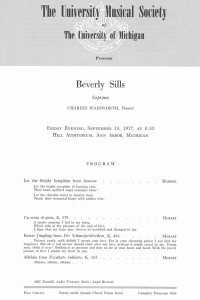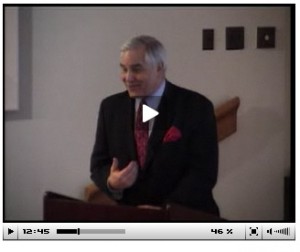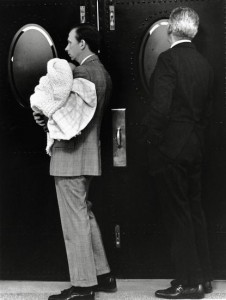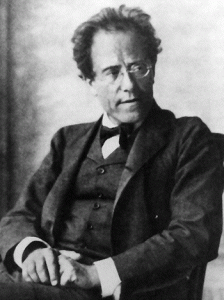This Day in UMS History: Beverly Sills (September 23, 1977)
This Day in UMS History – September 23, 1977
Hill Auditorium
Beverly Sills, soprano
Charles Wadsworth, piano
Let the Bright Seraphim from Samson–Handel
Un moto di gioia, K. 579–Mozart
Bester Jüngling from Der Schauspieldirektor, K. 486–Mozart
Alleluia from Exsultate Jubilate, K. 165–Mozart
Many artists presented by UMS over its 132-year history have a long and rich history of performances with the organization. Soprano Beverly Sills was certainly no exception. Throughout the 1970s, Beverly Sills made numerous appearances under UMS auspices, culminating with this, her final appearance in 1977, just a few short years before announcing her retirement in 1980.
The late 60s and early to mid 70s were considered the high points of Beverly Sills’ career, as evidenced by her appearance on the cover of Time magazine in 1971, where she was described as “America’s Queen of Opera.” Beverly Sills’ first UMS appearance on January 30, 1971 was also a solo recital with Charles Wadsworth accompanying her on piano. On that particular program, Sills sang three arias from Handel’s opera seria Giulio Cesare. It is interesting to note that in 1966, Sills’ performance as Cleopatra in the New York City Opera’s revival of Handel’s then virtually unknown Giulio Cesare, is what many argue made her an international opera star.
Her final UMS program featured an aria from Handel’s oratorio Samson, considered by many to be one of Handel’s finest dramatic works, as well as three pieces by Mozart: concert aria “Un moto di gioia”, “Bester Jüngling” from the comic singspiel Der Schauspieldirektor (one of the only four vocal numbers in that piece), and “Alleluia” from the final allegro section of Mozart’s religious solo motet Exsultate Jubilate.
Following her retirement from performing, Beverly Sills remained quite active with the New York City Opera, serving on their board until 1991. Following that, she also served as chairman of Lincoln Center until 2002, and then as chairman of the Metropolitan Opera. Beverly Sills lost her battle with lung cancer on July 2, 2007 at the age of 78.
I hope you will take a moment to enjoy the video below and hear for yourself (if you weren’t able to attend any of her UMS performances!) the beauty and purity of tone of Beverly Sills’ voice as she sings one of my all-time favorite Mozart arias “Ruhe sanft, mein holdes Leben” from Zaide.
Search Hundreds of Photos… and 100 Years of Concert Programs
Finally–the time has come! Thanks to the Ann Arbor District Library, we launched the beginnings of the UMS digital archive!
UMS President Ken Fischer launched the archive March 14, 2010, with a special talk about UMS’s history. You can watch the whole thing here:
The AADL has digitized the first 100 years of UMS concert programs as well as hundreds of photos from our photo archive. It’s a work in progress, but we couldn’t wait to share it with you.
The AADL is building a searchable database so that we can link all of this great history together. We’re also continuing to scan and tag photos, and making plans to digitize our old-fashioned card catalog of artists and repertoire, so that you can pick your favorite symphony and search for every time it was performed on our stages and by whom!
A quick walk through of the site.
Along the left hand side, you’ll see a menu with a few options:
Browse Programs: Here, you’ll find a comprehensive list of every concert from our first season through the 1978/1979 season. Click on a program, and you’ll see images of the concert program. Click on the images, and they will enlarge and given you an option to view them in full-screen.
Search Programs: Here, you’ll find a simple search box. Type in a keyword: a date, artist, piece title, composer, venue–click “search,” and it will pull up every program that matches your keyword. (Remember–it only covers programs through the 1978/79 season so far.)
Browse Images: My favorite! Scroll down to the search box and type in a keyword–an artist, company, venue–and it will pull up any photos that are tagged with that keyword. For example–if you type in “Bernstein”–you’ll see photos of Leonard Bernstein, photos of the Bernstein benefit, and tons of scanned contact sheets from his Ann Arbor visits (some of which only a few people have ever seen before!). Click on a photo to enlarge it. NOTE: When your search results appear, make sure to click the button under the search box that says “Show all #” as there may be more photos than the three that appear.
We hope you enjoy playing around with the site, and remember, there is MUCH MORE to come! Thanks so much to our great partners at the Ann Arbor District Library for helping us share our history. Stay tuned!
Hubbard Street Dance Chicago: Your Questions Answered!
Editor’s note: Hubbard Street Dance Chicago return to Ann Arbor on October 27, 2015.
To close out this season’s Dance Series, we had three mesmerizing performances by Hubbard Street Dance Chicago on April 22-24. For a long time, members of our staff had wanted to try out the concept of a “post-it wall” in the lobby for a performance. We thought it would be interesting to try this with a dance company because dance can inspire so many different feelings, interpretations, and questions.
Throughout the weekend, Company dancers and touring staff loved seeing your comments on the wall (as did other audience patrons and we)! There were three different opportunities to respond:
-Describe tonight in six words or less.
-What was your favorite piece?
-Leave a question for the Company.
Glenn Edgerton, Hubbard Street Dance Chicago’s Artistic Director, was kind enough to answer all the questions you left on the wall. Thanks, Glenn!
Last dance (Walking Mad): why not end on the high note? The slow piece at the end wore the audience down…you could have had a standing ovation without the slower dance.
Often choreographers like to contrast their work and basically “keep it real”. Once they give you that feeling of excitement and euphoria their thought process is to bring you back down to reality and emotionally give you one last profound statement to contemplate.
If you are sad during a performance do you have to smile?
As a dancer, you also have to be an actor. If the part requires a smile, then yes you have to be able to perform the work with the emotional content as it is intended.
Did another company perform Bitter Suite? Sounds familiar.
Jorma Elo has also made a work for Aspen Santa Fe Ballet called “Red Suite” but not sure if they ever performed in Ann Arbor. (UMS Note: Neither of these works have ever been performed under UMS auspices.)
Was the volume to the music for Walking Mad turned down on purpose? Why?
Yes, the music volume gets turned down to create the image of the music coming from another part of a house or space. Just prior to this moment the dancers are with party hats and dancing through the doorway evoking a party scene. Once they pass through, the space changes and traps the female dancer in another space and then the music is meant to seem like it is coming from a distance from where the party is happening on the other side of the wall.
Is this the only theater you perform at where the audience posts questions?
Yes, this was a unique idea of UMS.
How many times a week do you practice?
We rehearse five days a week. When there are performances however this might turn into six days a week.
How do you synchronize so accurately when the music is so nondescript from measure to measure?
Practice, practice, practice. But actually, once you work with music for a while it starts to become more apparent where the landmarks are at least.
When you turn off your cameras and cell phones during the performances how do the photographers get pictures for the brochure?
We have individual agreements with photographers to get pictures during technical rehearsals and sometimes in performances; consequently they are the only ones with the rights to keep their cameras turned on.
How many shows did you perform so far?
In Ann Arbor we had four performances in total—one was a school show.
Why not have the choreographers explain what they are trying to express?
The idea is to have your imagination cultivated during the performance and to find the expression that fits for you and your life.
Which dance was your favorite to perform, and why?
Since I am the artistic director I can’t answer that for the dancers but I know from my past and know from our current dancers, typically the most challenging work, physically and emotionally, becomes a dancer’s favorite; although as a director they are all supposed to be equally important.
Why not have a more descriptive breakdown of each program included in your guide?
This is a similar question from before; the description should be your description and not told to you but rather for you to create and imagine.
Why did you choose to portray violence?
If that is your image from what you saw that is certainly valid. I can’t imagine however, you thought it was all violent. We always try to show a wide range of emotions and physicality in one evening.
Are you all friends?
Yes, we are all friends. As with any group you are often closer to some than others but everyone gets along very well with each other.
Are your bows choreographed as part of the dance?
Bows are often the last thing to be rehearsed but yes they are planned.
How many weeks does it take to learn a piece?
Learning a piece and creating a piece are two different things. To learn a piece already existing can take as little as two weeks to four. Creating a new work for a third of an evening (approx. 25 min) usually takes four to five weeks.
How old were you when you started taking dance lessons?
Me personally, I was six. Each dancer has a different past and process to their dancing career.
How long have most of you been dancing?
Most of our dancers started at a young age, typically around eleven, but occasionally you will see a dancer who started at four and others who started at eighteen.
Do you struggle with injuries?
Injuries are an unfortunate reality to being a dancer. You are always trying to go further with your movements to increase your range of movement and dynamic qualities therefore strength issues and structural issues become a definite struggle.
Dude, wasn’t it awkward to have your family see you topless and still convince them you’re not that kind of dancer? –>Are you an idiot?
This was a two part comment. The subsequent post-it, asking the other messenger if he was an idiot, drew an arrow to the first question. I actually have strong opinions about both of these statements. Even the word topless makes me cringe. That part of the piece was meant to express vulnerability and a nakedness of raw emotion, not to be gratuitous or sexual in any way. The men did not wear shirts for the entire piece and therefore this moment when the woman doesn’t either, evokes a sense of equality and a double standard of nudity in our society. The second statement is a judgment that also makes me cringe. Each individual has their interpretation of the experience which I would hope is respected although I encourage each audience member to go deeper into his thoughts to find an aspect that makes him see beyond the obvious.
Do you eat fish?
I’m assuming this is a comment from a piece we have had in the repertory in the past called “Minus 16” where one of the dancers has spoken text, which he asks, “Do you eat fish?”
Is the chemistry between partners difficult to foster or does it come naturally?
Sometimes as a director you get an immediate sense of who will have chemistry with another and then there are other times surprises come forward in a very holistic way; each pairing is different.
How has your experience with the company resembled your image of Hubbard Street at the start?
I can only speak from my perspective but I have found that the company is much more down to earth and that the organization breathes a sense of humbleness and enthusiasm for the work whereas you might guess the opposite in such an internationally respected company.
When will you perform here next time?
As often as possible; there are no dates set as of now.
How is it decided which pieces will be performed together?
The pieces are discussed with the presenters of the venue to get a sense of their audience and what will fit best with them. There is always an attempt to show a versatile program with contrasting music, movement qualities, emotional qualities and production values.
What are you wearing on your feet?
Most often ballet shoes but some pieces are danced bare foot and others require a characterization in the costuming which would dictate what a dancer wears such as street shoes or dance sneakers.
When will you come to Rochester NY?
As often as possible; there are no dates set as of now.
Was the girl really topless? Sorry, color blind!
In the last pas de deux of 27’ 52”, the female and male dancers were bare chested.
Do you weight train?
Some dancers do weight training to enhance their strength during their spare time but it is not part of their work day.
Are you ever tempted to laugh while performing?
All the time. Usually some funny element happens during a performance but it’s up to the dancer to be so concentrated in their part and not let those things phase them or react to them.
Does your mother know what you’re up to?
If this is in regard to the nudity, the answer is yes. I believe every parent is extremely proud to have their child expressing art at this level.
Are you nervous before a show?
Always.
How long do you work on a show?
Each show is different depending on how often the pieces have been danced in the past, but about a month to five weeks is typical to prepare a new program.
How would you describe the earthquake in Chile?
The earthquake in Chile was surely devastating. We were meant to tour there prior to our engagement in Ann Arbor until this happened. Now we are scheduled for next spring 2011 to tour there. You could imagine an earthquake to be depicted in the final moments of 27’ 52”.
What does “staged by” mean after “choreographed by” is already listed?
The choreographer will generally send someone they designate to teach a piece on our dancers which means this person gets credit for “staging” the work whereas the choreographer still remains as the creator of the piece.
Here are some of our favorite responses to the other questions. Thanks to everyone who participated–we loved hearing from you!
Mahler and Me: Preparing Mahler’s Symphony No. 2 from a UMS Choral Union Perspective
As a member of the UMS Choral Union for the past three years, I have thoroughly enjoyed performing some of the great masterpieces of choral music: Handel’s Messiah, Verdi’s Requiem, and Beethoven’s Ninth Symphony, to name a few. It has only been in the past couple of years though, that I have felt especially drawn to Mahler and his symphonies– the depth of emotion in his music never ceases to affect me in a very profound way, and I have grown to truly love his work. Last year, I learned that the Choral Union would not only be performing Mahler’s Symphony No. 2 in c minor (“Resurrection”), but we would be performing it with the San Francisco Symphony and conductor Michael Tilson Thomas. To say I was excited by this news would have been an understatement! This would be my inaugural performance of one of Mahler’s symphonies and I couldn’t wait to get started! Fortunately, I didn’t have long to wait as the Choral Union, under the guidance of conductor and music director Jerry Blackstone, began rehearsing the piece in late September of this past year.
At our first rehearsal, I sat down before warm-ups began and opened the new choral score of Mahler No. 2 that I had just picked up. I was instantly struck by what I saw on the page: straight-forward rhythms, a fair amount of unison singing between voice parts, and an awful lot of German text (my favorite language to sing in, so I wasn’t complaining). It looked almost elementary in a way, but this is not the case at all, as I have come to discover in the past several months that I have lived with this piece. Also printed in the score are a multitude of dynamics and nearly thirty different markings Mahler included, giving very specific directions on what he wanted from the chorus at various points. For example (translated from German), “Without standing out in the least” and “Somewhat slowing down again” – it is clear all of these nuances were very important to Mahler, and the vision he had for this piece. They have been equally important and emphasized by our conductor, Jerry, throughout our rehearsals as well, with no subtlety being overlooked. We were fortunate enough to have one of our recent rehearsals led by Ragnar Bohlin, the conductor of the San Francisco Symphony Chorus. As Jerry mentions in my video conversation with him, included in this blog post, this was a great rehearsal in which Mr. Bohlin helped us perfect our intonation and unification as an ensemble.
The length of time the chorus sings in this piece is actually quite short; Mahler’s Symphony No. 2 is a five-movement symphony with the chorus coming in halfway through the final movement. The text is taken from a setting of Friedrich Gottlieb Klopstock’s Die Auferstehung (The Resurrection). It is quite powerful, and the music Mahler wrote for it very effectively paints the picture of the hope, renewal, and rebirth that the text describes. Jerry has paid careful attention to accurate and unified pronunciation of the German text throughout our preparation of this piece. As the text plays an integral part in conveying the emotion of the music, it has not been uncommon for him to stop us several times while rehearsing until every last vowel and syllable in a phrase is correct and sung beautifully. The orchestration when the chorus enters is minimal but builds to a full, lush sound which includes “the largest possible contingent of strings” (Mahler’s own words), seven different percussion players, the introduction of the organ, and the tolling of deep bells during the final moments of this piece.
Mahler wrote of the final movement of this symphony, “The increasing tension, working up to the final climax, is so tremendous that I don’t know myself, now that it is over, how I ever came to write it.” (Natalie Bauer-Lechner, Recollections of Gustav Mahler) I personally have been humbled by the genius of this piece, and am very eagerly anticipating the culmination of all of our rehearsals when the Choral Union shares the stage with the San Francisco Symphony and Michael Tilson Thomas on March 20 to perform this amazing work. I am quite certain this performance will be one of, if not the highlight of my singing career thus far!
Launching the UMS Lobby with Bela Fleck!
bright orange tablecloths + neon green t-shirts + fortune cookies + flip cams + an amazing concert with Bela Fleck = THE LAUNCH of the UMS LOBBY.
It was amazing to see many of you at the first Live Lobby Meet-Up after the Bela Fleck/Africa Project Concert on Feb. 17 in Hill Auditorium! Many UMS volunteers, staff, and student interns were on hand to talk about our new online community at www.umsLOBBY.org. Bela Fleck signed CDs after the show. And we hope you snagged a fortune cookie with a special message inside!
Audience members had some great things to say after the concert, and we tried to catch some of them on flip cam (see the video above — starring YOU!).
You can also see photos from the event here (if you had your pic taken with Bela Fleck, this is where you’ll find it):
Have more to say about the event? Join the conversation…
When the Bela Fleck performance ends, we hope you’ll stick around…
Join us in the Hill Auditorium lobby after the Bela Fleck concert this coming Wednesday, Feb 17th, for our first live UMS LOBBY event!
The UMS LOBBY is all about having great conversations with other people who enjoy the performing arts. So while you wait to have your CD signed by Bela, check out the new www.umsLOBBY.org site by using the laptop stations we’ll have setup in the main lobby at Hill Auditorium.
Share your views with fellow concert-goers both online and in-person, chat with UMS staff and volunteers, and checkout our special giveaways.
umsLOBBY.org is a new place to gather for conversation about arts and culture. Help us spread the word!
What are UMS LOBBY events?
The UMS LOBBY is all about having great conversations with other people who enjoy the performing arts. As we get to know each other through comments and conversation on www.umsLOBBY.org, we’ll also have the chance to meet face-to-face in a series of meet-ups over the remainder of the 09/10 season. The meet-ups are designed to complete the circle between the virtual world and the real world, providing opportunities for us to get to know each other a little better, interact with artists and experts, and dig a little deeper into what we love (and sometimes what we hate!) about live performance.
Mark your calendars: the first live UMS LOBBY event is planned for February 17 in the lobby of Hill Auditorium in conjunction with Béla Fleck’s Africa Project concert.
Let’s all go to the lobby!
Welcome to umsLOBBY.org!
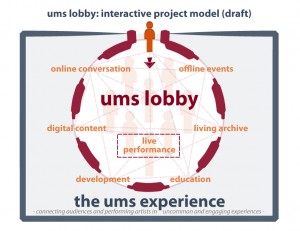 In June 2009, UMS was one of four organizations awarded an “Innovation Lab” grant by EMCArts, with support from the Doris Duke Charitable Foundation. The grants were awarded to allow organizations to develop an idea that could have a profound impact on how they do business.
In June 2009, UMS was one of four organizations awarded an “Innovation Lab” grant by EMCArts, with support from the Doris Duke Charitable Foundation. The grants were awarded to allow organizations to develop an idea that could have a profound impact on how they do business.
During the summer, a team of UMS staff members and volunteers researched new ideas related to social media. A week-long intensive retreat in October resulted in further development of this project. We’re now prototyping the UMS Lobby project with this new website and blog, and with several live events that will happen during the next three months as we wrap up the 09/10 season.
The UMS Lobby will expand and redefine what we mean by “the UMS experience.” By combining online and live components in everything UMS does, we’ll enable a greater amount of people to engage more continuously and deeply with each other, with the extraordinary history of UMS, with the artists we now present, and with the life of UMS in Ann Arbor and throughout the region.
The UMS Lobby is a place where people meet, exchange ideas, and build relationships — a bridge between daily life and the special places we devote to artistic experiences. UMS has many “lobbies,” and we’ll use these physical spaces in new ways to welcome our audiences and invite them to learn from us and from each other. And, of course, the learning goes both ways — we at UMS always find that we learn so much from you, our audiences, whenever we have the opportunity to meet up socially.
At the same time, the UMS Lobby is a virtual space, accessible year-round, where we will offer multiple streams of activity to engage anyone interested in art and ideas, or in UMS specifically. Among the virtual offerings — some of which are already active, and some of which are still in development:
- A multimedia blog with text, video, audio, photos, and links (that’s what you’re reading now!)
- Conversation areas that include feeds from our facebook, twitter, and other networks, but that also provide a place to listen and to be heard
- A digitized historical archive that includes access to UMS’s extraordinary 131-year history, including the opportunity to submit your own comments, memories, and observations about events that you’ve attended. We’re working closely with the Ann Arbor District Library to bring this project to fruition.
- Stories from patrons and others about the impact of UMS —in essence, a “living archive” that will grow with time and supplement the historical archive
So what does this mean for the regular UMS website? You can continue to visit www.ums.org for all of the information you need about UMS and upcoming events — sound clips, video clips, program notes, and information about purchasing tickets. Think of ums.org as a site filled with information, and umsLOBBY.org as a site filled with conversation.
So what do you think? What do you want to read more about? Let us know — we want to hear from you!
See you in the “Lobby”!



